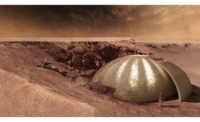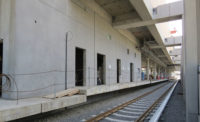A firm focused on 3D printed concrete is getting ready to print its first major structures in the United States. Contour Crafting’s gantry-supported 3D concrete printing robot is set to print sometime in the next few months, the firm’s board chairman Werner Bittner told ENR at the triennial Bauma equipment show in Munich, Germany, held April 8-14.
The plan is for six concrete structures, each at 60 sq. meters, to be built in a large city on the west coast of the United States, which Bittner wouldn’t name. Contour Crafting is a private venture set up by the University of Southern California professor and engineer Behrokh Khoshnevis; it is 30 percent owned by global formwork giant Doka. Bittner is Contour’s chairman of the board of directors as well as an executive board member at Umdasch Group Ventures; the family-owned Umdasch Group is Doka’s parent company and is headquartered in Amstetten, Austria.
A truncated robot system was on display in front of the Doka tent at the Bauma show. The full system will come in two versions, one capable of an eight-meter span (25 feet) and the other out to 12 meters across (40 feet). This is pretty much as planned when ENR reported on Contour Crafting at the time of the Doka deal in 2017. The version on display at the show is close to production-ready, though it did not have the full extent of its gantry tracks and was missing the real nozzle and admixture feeder, which is still a trade secret.
Bittner said the display was accurate in all other respects, only needing one operator to run it and ensure that the software is running smoothly. An additional worker is only needed to set up the machine, which when fully-rigged will weigh in at 650 kilograms (1,433 pounds) and be rated to print an entire single-story building. Bittner says after the first site run in a few months, which should act as a proof of concept, the Umdasch plans to purchase a set of robots and launch a printing-as-a-service venture with it. After that is established, Contour Crafting plans to sell the concrete printer commercially.
Bittner is particularly keen on the materials on hand for the robot: standard concrete, tempered a little in order to increase fluidity and cure a little faster, as previously reported in ENR. “Only concrete is concrete,” he says. This should separate the robot printer from machines that pour mortar for other structures rather than straight in situ poured concrete, he added.
Contour Crafting says its printer will be used for social housing, bungalows, military use, temporary structures and disaster relief. A price has not yet been announced.



Post a comment to this article
Report Abusive Comment